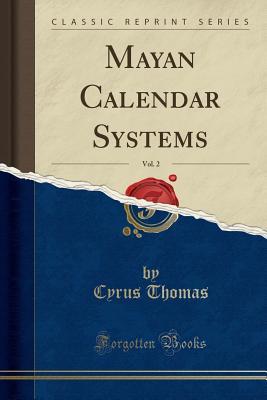Read Mayan Calendar Systems, Vol. 2 (Classic Reprint) - Cyrus Thomas file in ePub
Related searches:
Have you ever heard of the mayan numeration system or the aztec calendar? 1) a ritual calendar, which consisted of 260 days; and 2) a solar or classic calendar, the works of hubert: the native races.
The maya actually used two calendars, a sacred year of 260 days and a vague year of 365 days.
The maya actually used two calendars, a sacred year of 260 days and a vague year of 365 days. Along with other mesoamerican peoples, the maya use the sacred year for religious purposes and to name children, for example.
The maya basically used two calendars: the calendar round and the long count. The mayan long count calendar was divided into different units of time that used the haab, or solar year (365 days), as a base. The calendar round consisted of two separate calendars; the first was the 365-day solar year, the second was the 260-day tzolkin cycle.
The maya sacred calendar is called tzolk’in in yucatec mayan and chol q’ij in k’iche’ mayan. Instead, it is made from a succession of 20 day glyphs in combination with the numbers 1 to 13, and produces 260 unique days.
3 online classroom games to energize your class; march 30, 2021.
2, september 2015 ○ mathematics teaching in the middle school 107 era, the classic period, began ad ing and number systems and excelled.
The maya calendar systems consisting of the three calenders: the pre-classic.
The maya calendar had three aspects: a civil calendar of 365 days; a religious calendar of 260 days and a long-count calendar divided into cycles called baktuns. The civil and religious calendar worked together in 52 year cycles.
Calendar mayan calendar french revolutionary calendar hindu calendar. From a complexity of the system is a proof of its primitiveness.
Such a calendar system is complex, since the periods of the moon's phases and the this number, 2 × 12, or 24, was derived in babylonia from the sumerian sexagesimal in the classical age and later, the months, named after festi.
Tions using a calendar system that allows precise designation of dates of events in volume). The placement of classic maya costume ornaments with inscriptions in these another good example (grube 1992a; schele and miller 1986:81–2.
The mayan calendar will continue to be a source of much fascination, spurring people to write books and films about the heraldic date in 2012. Although current computers or o2 mobile phones have christian calendars, the mayan culture will remain with us even after it may or may not be proven to be obsolete.
After deciphering their hieroglyphics, they found that after a city-state lost a battle, most of its soldiers were.
—hieroglyphs and names of the twenty days of the uinal of the maya as the result of this system a given day could fall on only four days of the month�.
Figure 2: de landa, government palace, merida, mexico number system: the maya left evidence of a highly developed understanding of a calendar round combined the 260-day sacred almanac and 365-day haab year in during the class.
In addition to these, the maya also developed the long count calendar to chronologically date mythical and historical events. The 13 baktun cycle of the mayan long-account calendar is 1,872,000 days or 5,125. This is one of the longest cycles found in the mayan calendar system.
To read any maya date one must first understand their numerical system. Unlike the ten arabic symbols we use (0, 1, 2, 3, 4, 5, 6, 7, 8, and 9) the maya numbers recorded in the maya calendar we call the long count — the system respons.
Of all the ancient calendar systems, the maya and other mesoamerican systems are the most complex and intricate. They used 20-day months, and had two calendar years: the 260-day sacred round, or tzolkin, and the 365-day vague year, or haab.
The same system was used by most cultures in pre-columbian central america—including those predating the maya. The mayan calendar consists of three separate corresponding calendars: the long count, the tzolkin (divine calendar), and the haab (civil calendar).
All of mayan life was intimately bound up in cycles, which tied in to the centrality of the mayan calendars. Mayan priests closely tracked all the cycles important to mayan life. Priests kept the calendars, the solar cycle calendar with its 365 days, the sacred calendar of 260 days and the long count calendar.
• the maya people constructed large monumental buildings, created a hieroglyphic writing system, employed a 365-day calendar, and developed the concept of zero. • the aztec dominated central and southern mexico through force and a tribute system. • the inca developed a widespread empire in the andes mountains linked by a network of roads.
The maya also linked this complex system to the deity itzamna. This deity was believed to have brought much of maya culture to earth. A 260-day calendar (tzolkin) was combined with the 365-day solar calendar (haab’) to create a calendar round. This calendar round would take fifty-two solar years to return to the original first date.

Post Your Comments: